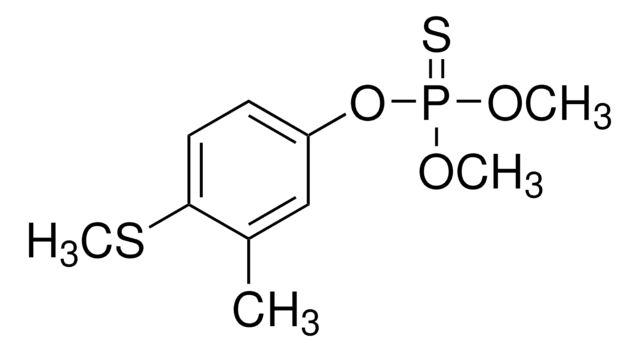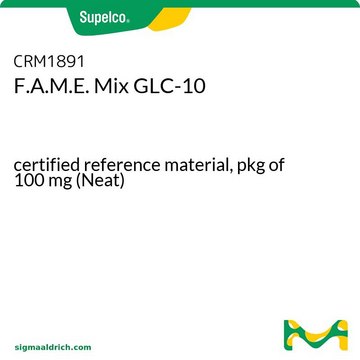CRM18918
F.A.M.E. Mix
C8 - C24, certified reference material, ampule of 100 mg (Neat)
Sign Into View Organizational & Contract Pricing
All Photos(1)
About This Item
UNSPSC Code:
85151701
NACRES:
NA.24
Recommended Products
grade
certified reference material
TraceCERT®
product line
TraceCERT®
CofA
current certificate can be downloaded
packaging
ampule of 100 mg (Neat)
technique(s)
HPLC: suitable
gas chromatography (GC): suitable
application(s)
food and beverages
format
mixture
functional group
carboxylic acid
ester
shipped in
dry ice
storage temp.
-10 to -25°C
Related Categories
General description
This Certified Reference Material (CRM) is produced and certified in accordance with ISO 17034 and ISO/IEC 17025. All information regarding the use of this CRM can be found on the certificate of analysis.
Application
The CRM has been used as follows:
- To determine the fatty acid content in the study to investigate the catalytic activity of Fe-exchanged montmorillonite K10 (Fe-MMT K10) in the conversion of waste cooking oil to biodiesel
- Assessment of fatty acids in the native microalgal species by gas chromatography-mass spectrometry (GC-MS) to evaluate their lipid content and biomass productivity
- Fatty acid profiling of oil extracted from grape seeds using GC-MS to study the effect of ultrasound technology on the three extraction methodologies based on low-pressure Soxhlet and Bligh Dyer, and high-pressure supercritical carbon dioxide-SFE
- To evaluate the fatty acid composition of the biodiesel obtained from the wastewater treatment high-rate algal pond (WWT HRAP) biomass using GC-FID
Other Notes
Refer to the product′s Certificate of Analysis for more information on a suitable instrument technique. Contact Technical Service for further support.
Legal Information
TraceCERT is a registered trademark of Merck KGaA, Darmstadt, Germany
Analyte
Description
Methyl arachidate 8 wt. %
Methyl behenate 8 wt. %
Methyl decanoate 8 wt. %
Methyl cis-13-docosenoate 5 wt. %
Methyl dodecanoate 8 wt. %
Methyl linoleate
Methyl linolenate 5 wt. %
Methyl myristate 8 wt. %
Methyl octanoate 8 wt. %
Methyl oleate 5 wt. %
Methyl palmitate 11 wt. %
Methyl palmitoleate 5 wt. %
Methyl stearate 8 wt. %
Methyl tetracosanoate 8 wt. %
See All (14)
Related product
Product No.
Description
Pricing
signalword
Warning
hcodes
pcodes
Hazard Classifications
Aquatic Acute 1 - Aquatic Chronic 3
Storage Class
10 - Combustible liquids
wgk_germany
WGK 3
flash_point_f
Not applicable
flash_point_c
Not applicable
Choose from one of the most recent versions:
Already Own This Product?
Find documentation for the products that you have recently purchased in the Document Library.
Customers Also Viewed
Yung-Yu Tsai et al.
Journal of bioscience and bioengineering, 127(4), 430-440 (2018-10-15)
The oil plants provide a sufficient source of renewable lipid production for alternative fuel and chemical supplies as an alternative to the depleting fossil source, but the environmental effect from these plants' cropping is a concern. The high oleic acid
S Hackenschmidt et al.
FEMS yeast research, 19(7) (2019-10-13)
Despite the increasing relevance, ranging from academic research to industrial applications, only a limited number of non-conventional, oleaginous Yarrowia lipolytica strains are characterized in detail. Therefore, we analyzed three strains in regard to their metabolic and physiological properties, especially with
Ayoma Witharana et al.
Environmental technology, 39(16), 2062-2072 (2017-07-01)
Fats, oils and grease (FOG) congregate in grease traps and are a slowly biodegradable particulate organic matter, which may require enzymatic or hydrolytic conversion to form readily biodegradable soluble organic matter. The existing treatment methods employ water-based hydrolysis of FOG
Maria Grazia Melilli et al.
Foods (Basel, Switzerland), 9(6) (2020-06-14)
The addition of functional ingredients to breads could have effects on preventing cardiovascular diseases, cancers and inflammation. The incorporation of 0-5-10-15% of three populations of dried purslane flour on the rheological, sensorial and nutritional quality of fortified durum wheat breads
Rosa Marchetti et al.
Applied microbiology and biotechnology, 103(19), 8267-8279 (2019-08-30)
Recycling of waste cooking oil greatly reduces the environmental impact of its disposal. As fats can give rise to high methane yields, the use of waste cooking oil for biogas production seems a promising solution. The aim of this work
Our team of scientists has experience in all areas of research including Life Science, Material Science, Chemical Synthesis, Chromatography, Analytical and many others.
Contact Technical Service











